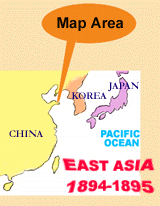

| On the lighter side . . . |
|
|
|

 |
Batteries or forts, total 161 guns, mostly of Krupp or Armstrong make |
|---|---|
| 1 | North group of forts, with 43 guns, 7-24 cm calibre. Captured on 2 February 1895 |
| 2 | Weiheiwei Harbour, harbouring 15 Chinese warships and 13 torpedo boats, and protected at its entrances by 248 sea-mines and by booms of timber and steel |
 |
3 Liugongdao Island, Admiralty of the Peiyang (North Waters) Fleet. With 61 guns. Under total siege by 8 February |
| 4 | Ridao Island, with 8 guns. Forts destroyed on 7 February |
| 5 | Ting Yuan, 7430-ton steel-hull battleship, flagship of the Peiyang Fleet of China |
| 6 | Matsushima, 4278-ton protected cruiser, flagship of the Combined Squadrons of Japan |
| 7 | South group of forts, with 49 guns, 7-28 cm calibre. Captured on 30 January |
| 8 | Position of the Combined Squadrons of Japan: 25 warships and 16 torpedo boats, commanded by Vice-Admiral ITO Sukeyuki |
| 9 | Town of Weihaiwei. Taken on 2 February |
The battle was fought in severe winter cold which developed into an overpowering snow storm on 31 January and 1 February. Temperature dropped to minus 26 degrees Celsius. Fighting men and men-of-war braved themselves against roaring winds and towering waves, as well as against one another.
Outline of map based on T. C. Tsen & M. C. Chao,  The Naval Engagements of the Sino-Japanese War
of 1894-95 and Li Hung-chang (Taipei, 1979). Text in Chinese.
The Naval Engagements of the Sino-Japanese War
of 1894-95 and Li Hung-chang (Taipei, 1979). Text in Chinese.
Additional reference:  Kinsei teikoku kaigun shiyo (Tokyo: 1938, reprinted 1974)
Kinsei teikoku kaigun shiyo (Tokyo: 1938, reprinted 1974)
